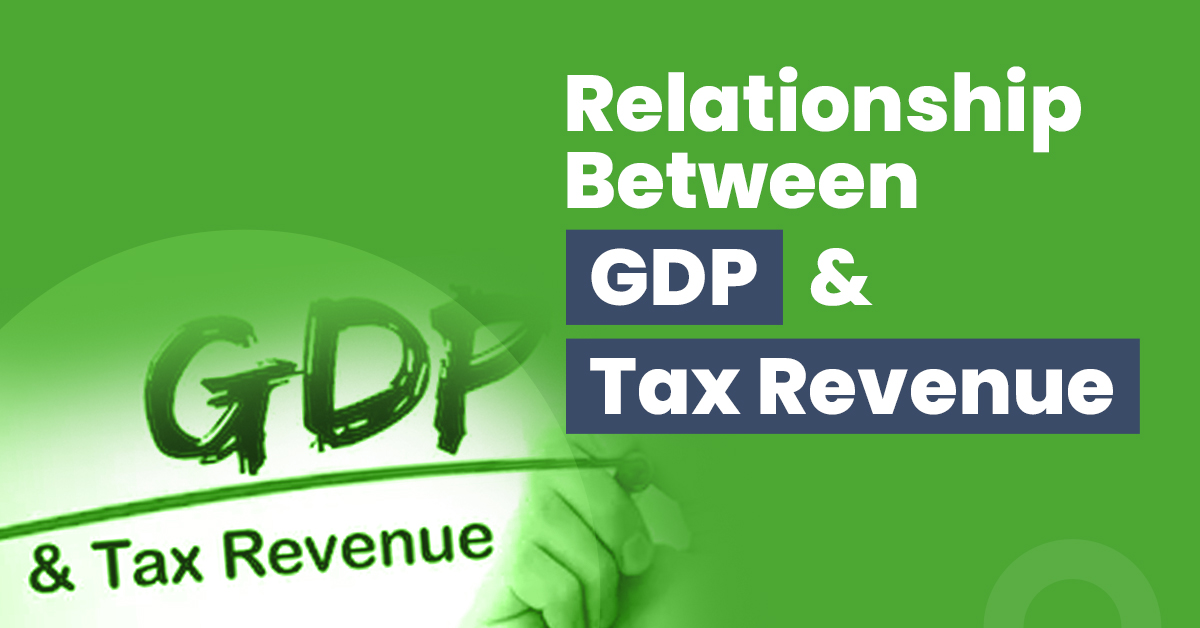Relationship between GDP and Tax Revenue


There are many factors that determine the economy of a nation and its position on the global stage. One such factor is the ratio of tax to GDP. It signifies the capacity of a country to fund its own expenditure, implement future development plans and secure itself against persistent deficits.
Read on to learn more about the relationship between GDP and tax revenues and how it impacts the Indian economy.
What Is GDP?
Gross Domestic Product (GDP) refers to a measure of the monetary value of all final products, services and goods produced by a nation within a given time. Generally, the GDP of a country can be calculated in three ways:
- Value added approach
- Income approach
- Expenditure approach
The main purpose of GDP is to capture how the nation is doing economically.
What Is Tax Revenue?
Tax revenues include the revenues collected by implementing direct and indirect taxes. It includes taxes from taxpayers on their income, property ownership, property transfer, social security contributions, payroll taxes, profits, taxes on various products and services, gifts, etc.
How Are GDP and Tax Revenues Related?
When the government charges tax revenues, it collects a share or percentage of the country’s domestic output. This is one of the ways the government controls the resources of a country. Therefore GDP and tax revenue together indicate the economic position as well as its potential for future growth.
The government collects a percentage of the nation’s GDP as tax revenues, which is calculated through the tax-GDP ratio. Developed nations tend to have a higher income and therefore have better capability to purchase goods and services and pay taxes. It also increases the demand for better government facilities such as infrastructure, free education, social development, etc. The higher the tax to GDP ratio is, the better the country’s economic health.
Therefore, western countries tend to have stronger tax revenue and GDP relationships than countries with a lower income source and high government expenditure. According to the World Bank, a 15% GDP ratio is considered suitable towards a growing economy.
Tax Revenue and GDP Relationship in India
As of June 2022, the ratio of tax revenues to its GDP was 7.8%. Although an increase from 5.2% in the previous quarter (March 2022) is found, India is still behind a lot of other developing countries. This indicates the government’s inability to fund its expenditure, such as infrastructure, education, employment, etc.
The average ratio of tax revenues to Gross Domestic Product from June 1997 to June 2022 is 7.3%.
The GDP and tax revenue relation is complicated and changes from time to time depending on a nation’s economic strength. Therefore, a tax to GDP ratio is used as a measure to understand their relationship.
Importance of Tax to GDP Ratio
As mentioned above, a higher tax to GDP ratio indicates a strong financial position of a country. It shows that a country’s tax revenues are positively related to its potential GDP, thereby maintaining strong tax buoyancy.
This plays a significant role in understanding the economic conditions of a nation. As changes take place in a country’s tax policies and tax rates, its economic activities get affected. This affects GDP, and hence the economic output of a country.
If the tax to GDP ratio is low, then it means that the government is unable to finance its expenditures, such as infrastructure, employee salaries, public services, etc., without borrowing from an external source.
What Is the Reason behind India’s Low Tax to GDP Ratio?
India’s inability to improve its Tax-GDP ratio can be linked to the following reasons:
- The first important factor that contributes to a low tax-GDP ratio in India is its significantly low tax base. Only 6.25% of the Indian population pays tax in our country. Although several initiatives have been taken to improve this number, only around 8.2 crores out of 132 crore population are on the tax list.
- Secondly, India lacks in implementing a strong tax administration. As a result, even though the Indian tax rate is high, tax contribution rate is comparatively lower due to tax evasion, exemptions, etc.
- Increasing poverty and low per capita income are other factors that result in low income, thus, the inability to contribute to taxes.
- Lastly, there are several government policies that allow large private-sector tax exemptions.
Consequences of Low Tax-GDP Ratio
If a nation’s tax revenues decrease, it will eventually affect the government’s ability to fund its own expenditure for public services, national security, socio-economic welfare, etc.
This will lead to dependence on external funding and borrowing, which ensures a continuing deficit in the national economy and leads to a discriminatory fiscal policy.
Moreover, lower direct tax collection also leads to more dependence on indirect taxes such as sales tax, VATs, etc., which is regressive for economic health.
Such a system creates political incentives for the government to borrow money to buy votes rather than work on building an effective tax system that will lead to economic growth and development.
Lastly, as the tax to GDP ratio decreases, the ability of a government to control a country’s economic resources diminishes, leading to socio-economic inequality and irregular distribution of economic resources, as witnessed in India. External borrowing also increases the interest burden of the country.
Possible Measures to Improve Tax to GDP Ratio in India
The first measure to improve the tax to GDP ratio is to widen the tax base and ensure that there is no tax evasion.
To achieve that, it has to improve its tax administration and reform tax policies and structure.
- Improving tax administration: India has taken a step to improve this through Aadhar Card and PAN card link, use of e-bills, etc. Tax evasion can be reduced through a stricter method of keeping track of individual income and transactions. In India, PAN-based transactions and other technological innovations have significantly contributed to efficient tax administration.
- Reforming tax policies and structure: Tax rates in India are comparatively higher than in most other countries. This should be reduced to an optimum rate so as to avoid evasions and delays. In addition, unnecessary exemptions should be eliminated from private sectors to increase taxes from high potential companies. The new tax regime is an appreciable step in this direction.
Final Word
Several reformations of the government and fiscal policies in India have helped improve the tax to GDP ratio in the last five years. The GDP in 2022-2023 is projected to grow ~8% through various private and public sector investments and tax reforms. With steady growth in its GDP, India’s economy can achieve macroeconomic stability and economic boost through the right tax reforms.
Frequently Asked Questions
Can cutting taxes help the economy?
Initially, cutting taxes may seem helpful as individuals will receive more money in hand, and companies can increase their investments, recruitment, and development. However, in the long run, it will not help the economy as the government will have less control over the economy, creating an irregular distribution of facilities and services.
How can GDP be calculated?
GDP can be calculated using three approaches: expenditure approach: how much is spent by the final user on final produced services and goods; production approach: value added in the production of a final good or service; and income approach: total income generated through the production of a service or goods.
Which country has the highest tax to GDP ratio and why?
Denmark has the highest GDP Ratio of 46.3%. This is due to their high tax rates and multiple types of taxes paid to the municipality and the state.




